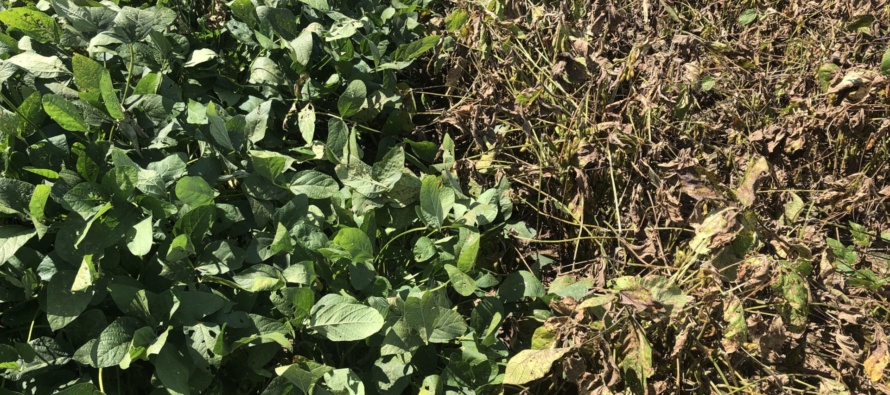2019 Soybean OVT Foliar Disease Evaluations: Maturity Group IV

Related Articles
- 2010 Soybean And Corn Variety Trial Data 3
- Rice Variety Trial Results For 2010, Plus Rice Research Report 0
- Evaluation of Peanut Varieties in Mississippi, 2010 0
Latest Tweets

The differences between varieties and their response to Southern blight can be quite evident in OVTs.
Field evaluations of the Maturity Group IV entries in the MSU OVT were conducted at each of the locations where trials were planted (Brooksville (n=2), Clarksdale, Longwood, Olive Branch, Raymond, Stoneville (n=3), Tippo, and Verona). Entries were observed for their reaction to the diseases that occurred at each location. Cercospora blight, frogeye leaf spot (when present), Septoria brown spot, southern blight, and target spot were the most common diseases encountered at each location. However, 2019, similar to the 2018 season, was not a good year for frogeye evaluations. But, with that in mind, the limited amount of information as gathered are included since frogeye seems to be the main disease requested on an annual basis. Be mindful that the ratings as presented are likely not as complete as they would be in a year when frogeye leaf spot produces more disease. Plots were observed between R6 and R6.5. Field evaluations for the presence of foliar disease were conducted using a 0 to 9 scale whereby 0=no disease and 9=excessive disease symptoms. Cercospora leaf blight was evaluated based on the presence of disease on leaves (0 to 5), petioles (6), and on pods and stems (7 to 9) based on disease intensity as assessed by coloration of plant material (leaves with distinct purple coloration and petioles, pods and main stems with purple to near black coloration). Septoria brown spot and target spot were evaluated in a similar fashion based on the presence of the disease within the plant canopy so that 0 to 3 indicated the presence in the lower canopy, 4 to 5 in the middle canopy, 6 to 8 in the upper canopy, and 9 indicative of extensive defoliation throughout the entire plant canopy and the disease in the upper most canopy. Southern blight was based on the presence of the disease within the entire plot based on a 0 to 9 scale where 0=no disease, 5=approximately half of the plot exhibiting symptoms and 9=severe southern blight characterized by dead plants. In a lot of cases, signs associated with southern blight (either white fungal growth or sclerotia) were observed at the base of infected plants.
Note that locations with a non-irrigated trial are marked as location (N) with an “N” in parentheses to indicate non-irrigated.
Maturity Group IV Early Xtend (n=11 locations):
Cercospora blight MG IV early Xtend Cercospora blight
Frogeye leaf spot MG IV Early Xtend frogeye
Septoria brown spot MG IV early Xtend Septoria
Southern blight MG IV early Xtend Southern blight
Target spot MG IV early Xtend Target spot
Maturity Group IV Late Xtend (n=11 locations):
Cercospora blight MG IV late Xtend Cercospora blight
Frogeye leaf spot MG IV late Xtend frogeye
Septoria brown spot MG IV late Xtend Septoria
Southern blight MG IV late Xtend Southern blight
Target spot MG IV late Xtend Target spot
Maturity Group IV Conventional (n=2 locations):
Cercospora blight MG IV Conventional Cercospora blight
Frogeye leaf spot MG IV Conventional frogeye
Septoria brown spot MG IV Conventional Septoria
Southern blight MG IV Conventional Southern blight
Target spot MG IV Conventional Target spot
Maturity Group IV LibertyLink (n=4 locations):
Cercospora blight MG IV LL Cercospora blight
Frogeye leaf spot MG IV LL frogeye
Septoria brown spot MG IV LL Septoria
Southern blight MG IV LL Southern blight
Target spot MG IV LL Target spot
Maturity Group IV Enlist/RoundUp Ready (n=10 locations):
Cercospora blight MG IV RR Enlist Cercospora blight
Frogeye leaf spot MG IV Enlist RR frogeye
Septoria brown spot MG IV Enlist RR Septoria
Southern blight MG IV Enlist RR Southern blight
Target spot MG IV Enlist RR Target spot




Let me tell You a sad story ! There are no comments yet, but You can be first one to comment this article.
Write a comment